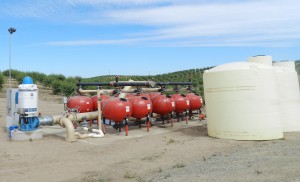
Dr. Vance Kennedy is a retired research hydrologist, with degrees in chemical engineering, geochemistry, and geology.
There are hundreds of deep wells in the foothills east of the San Joaquin Valley, especially in Stanislaus and Merced Counties. They are depleting the general water table at an alarming rate. When that water table drops by several hundred feet, no one will be able to live there who relies on groundwater because the cost of pumping will be too great for anyone to afford.
Such a situation is rapidly developing because thousands of acres of water-thirsty almond trees have been planted, with groundwater the overwhelming source of water. Existing ranchers and homeowners will be wiped out financially, with no legal recourse, as their wells are drained dry.
An average of perhaps 10 percent of the pore space in rocks in the foothills contains water that can be drained by wells. Therefore, if you pump a foot of water out of the rocks, the water table could drop by 10 feet. It is simply a mass balance. But things are not as simple as that sounds. Nearby groundwater flows laterally to replace the water withdrawn.
The average rainfall in the foothills is less than 15 inches, of which probably no more than 6 inches drains to the water table (the rest runs off). But the average almond tree needs at least 30 inches of water to survive; most need more. With no restrictions on how much a farmer can pump, the amount may be as much as 40 or 50 inches per year.
But if we use the minimum of only 30 inches, it still means that in the 25 year life of some almond orchards the water table could drop 500 feet, assuming no lateral movement of groundwater. But groundwater does move laterally, and quite easily, if the groundwater is being drawn from a highly permeable aquifer.

In fact, that is the only kind that exists. If it is not permeable, it is not an aquifer. Productive aquifers can extend under many adjoining properties, so a single very large well can, and will, affect the water table for many thousands of feet in all directions, though unrecognized on the surface.
California law allows a landowner to pump as much water as he wants from his own land. It ignores the underground connection of aquifers. Even though it recently implemented the Sustainable Groundwater Management Act, the state is legally still in the stone ages as far as groundwater is concerned—the groundwater act requires a twenty year rollout, far too long to prevent disastrous outcomes in many places. In fact, it was only recently that the state recognized the connection between surface water and groundwater legally. (California hydrologists are at least as knowledgeable as those anywhere else; the politicians and special interests are the problem).
In Stanislaus County and elsewhere, rules prohibit the public from learning how much water a single well is pumping, so a neighbor has no ability to learn how much harm is being done to the general water table, and hence to him or her. The law should require release of pumping information so that the public can know how fast the overall water table is being depleted. After all, groundwater is a public resource and suppression of well production records should be illegal.
Large wells in the foothills are withdrawing a very valuable resource that cannot be replaced in perhaps a 1000 years, even if we stopped pumping after only one orchard life. This is a slow disaster that cannot be prevented under present California law. An effort must be made to alert the general public to certain disaster, unless present laws are changed. This is an effort to document the situation ahead of time.

Excellent article. We are going to have a crisis soon no matter what we do or especially if we do nothing.
[…] many observers, including retired hydrologist Vance Kennedy, believe groundwater regulation is still far too lax to have truly beneficial effects. For one […]
What large wells in the foothills?
Most of the large wells in the foothills are in service to the tens of thousands of acres of recently planted almond orchards.